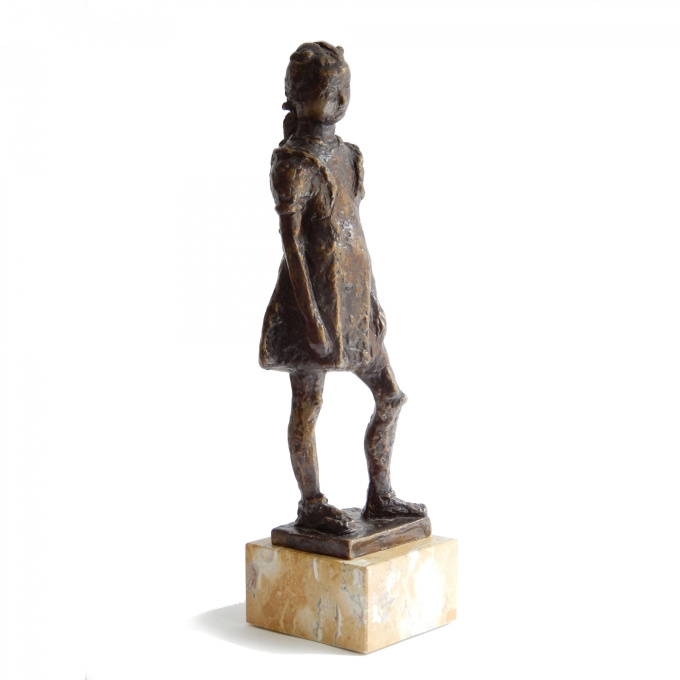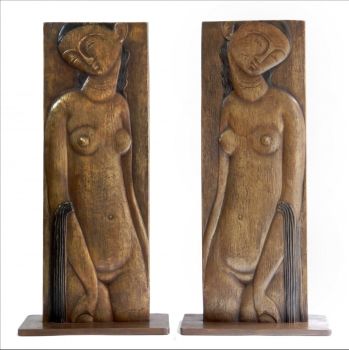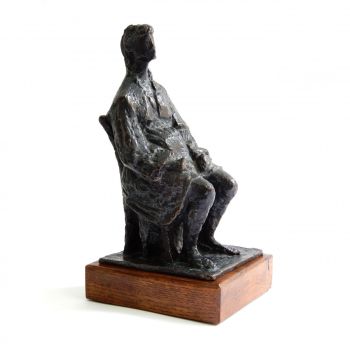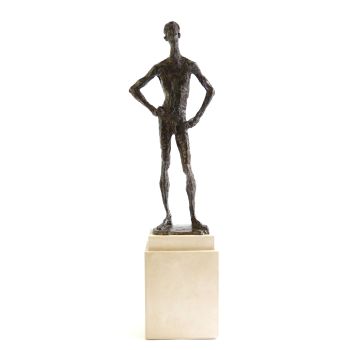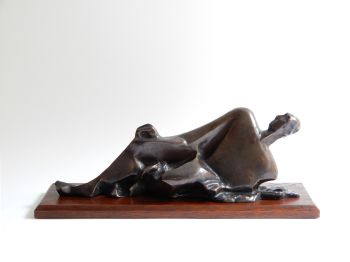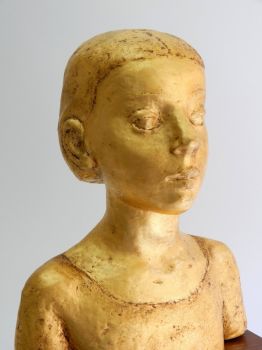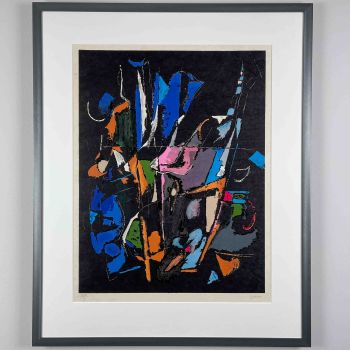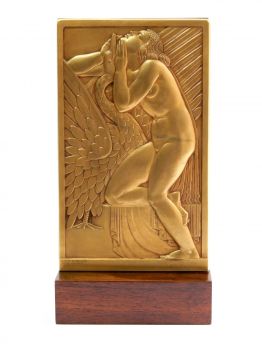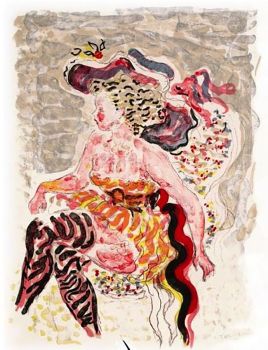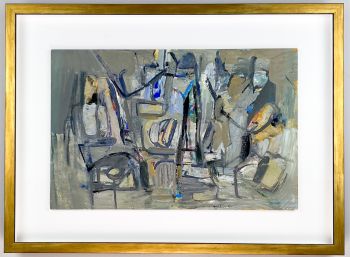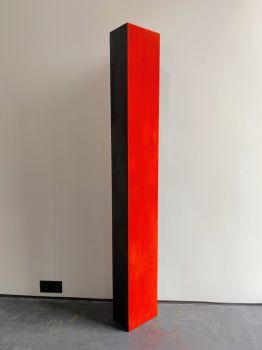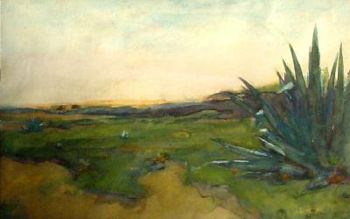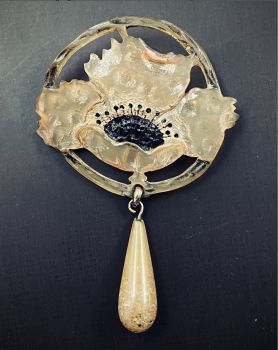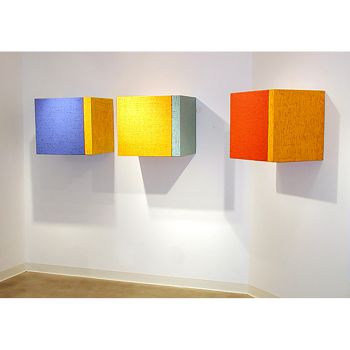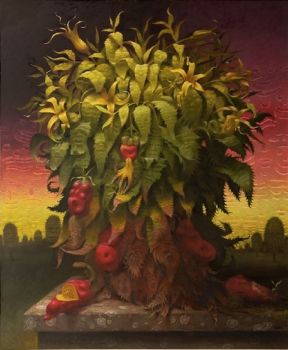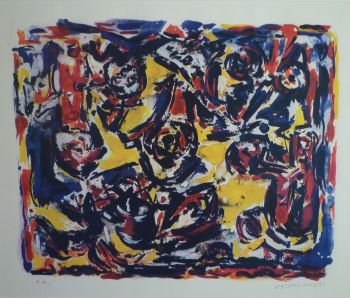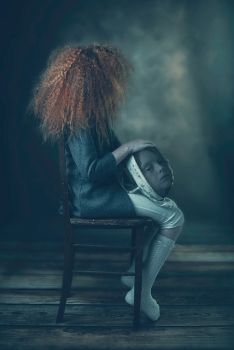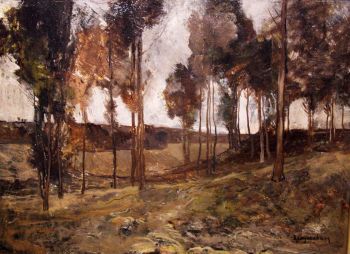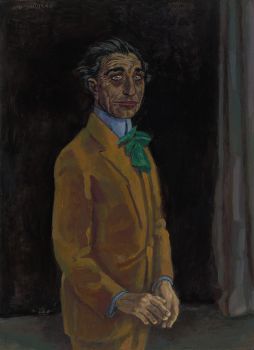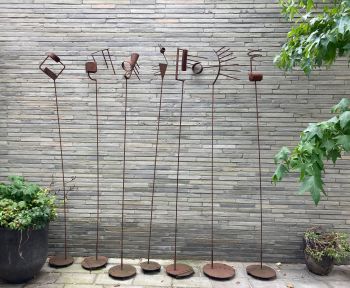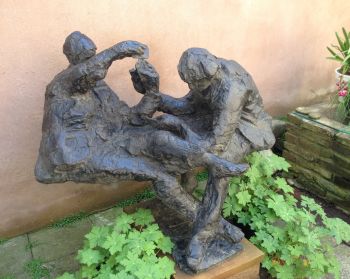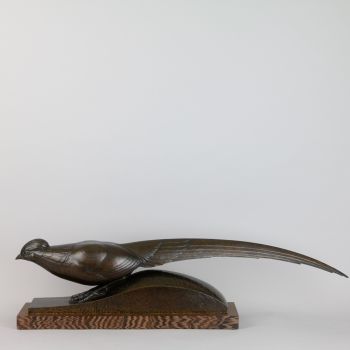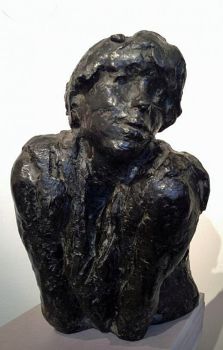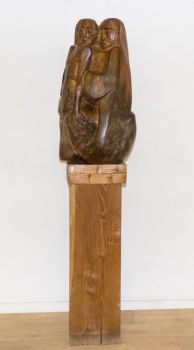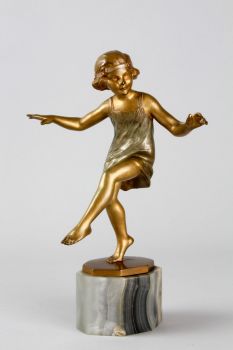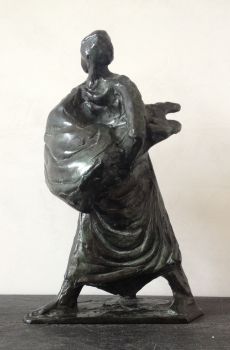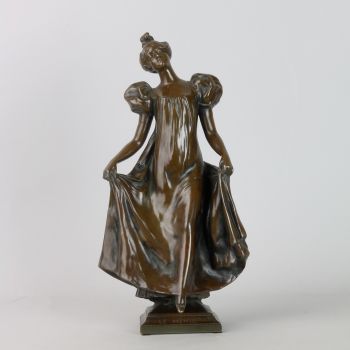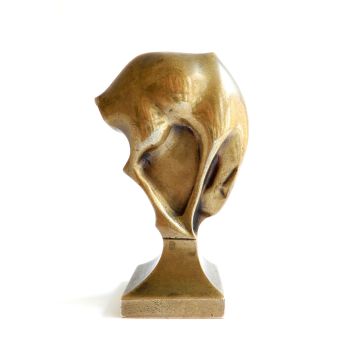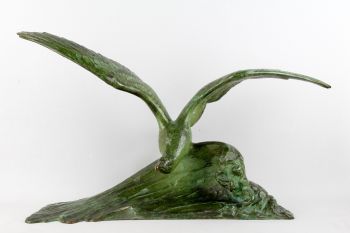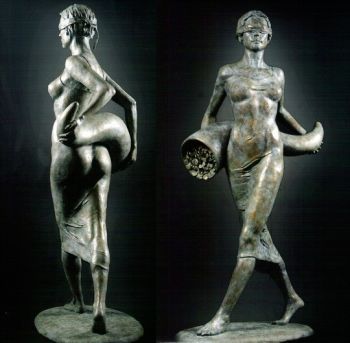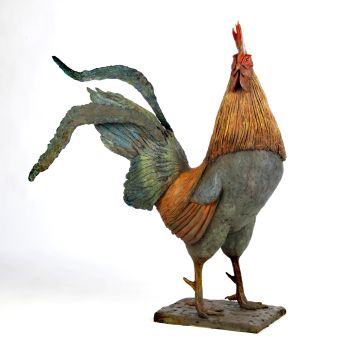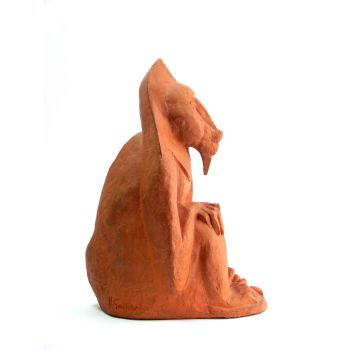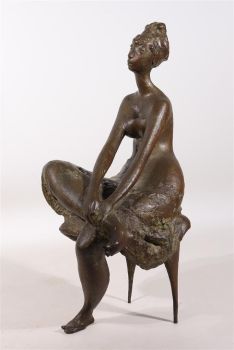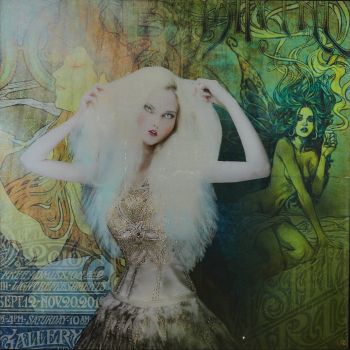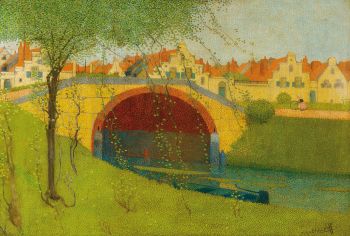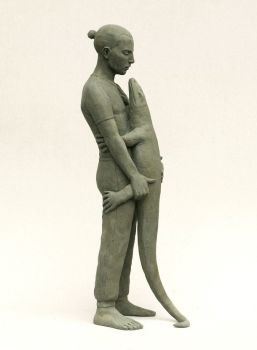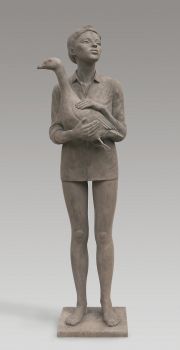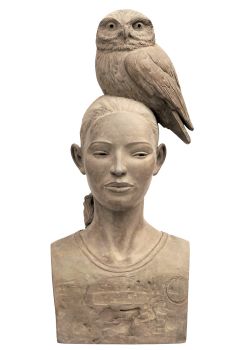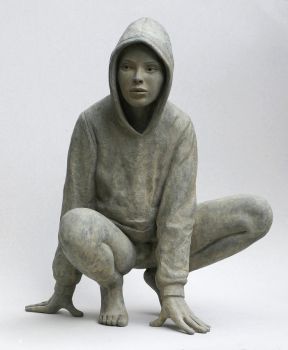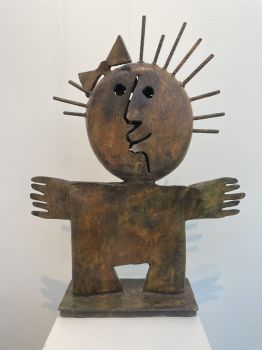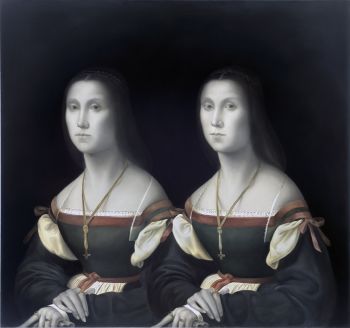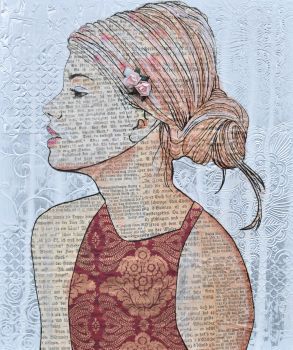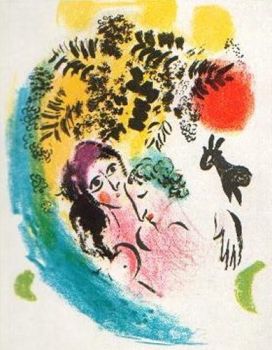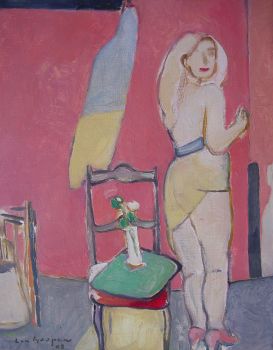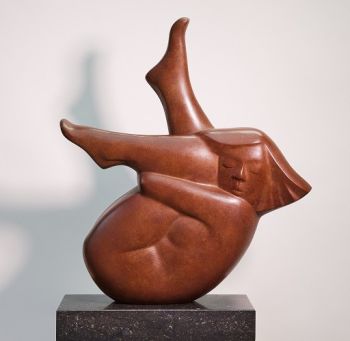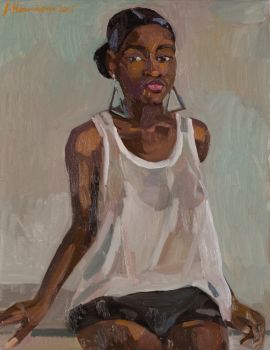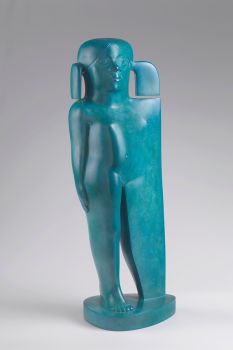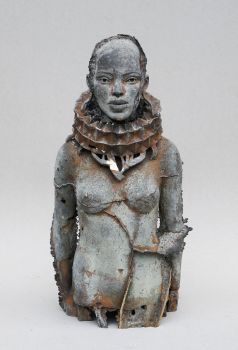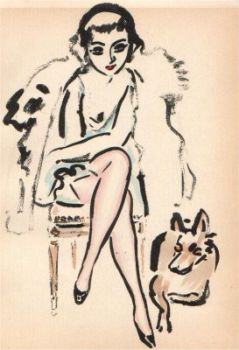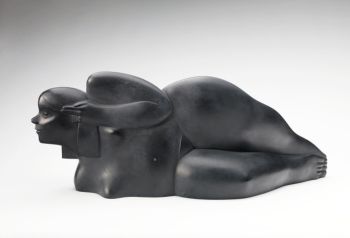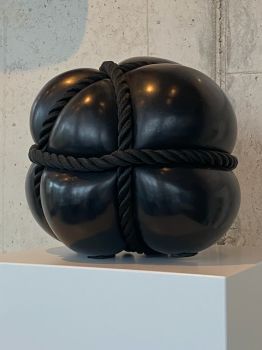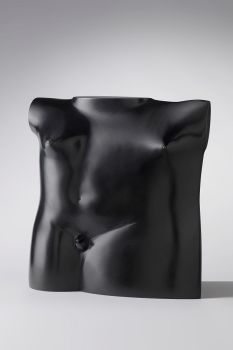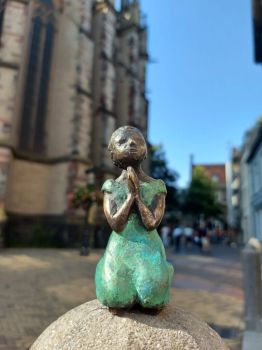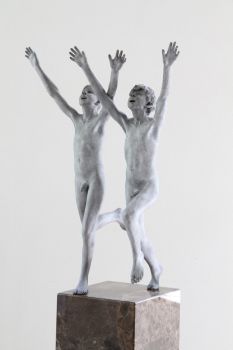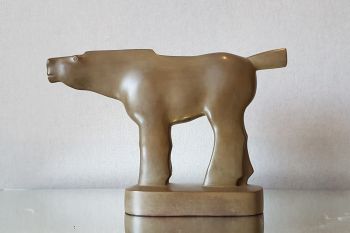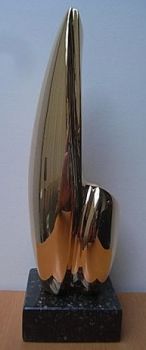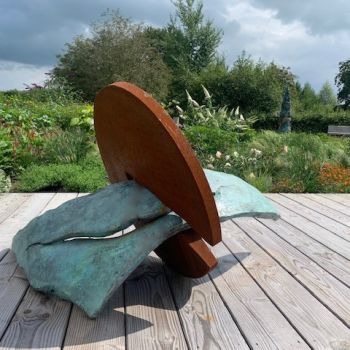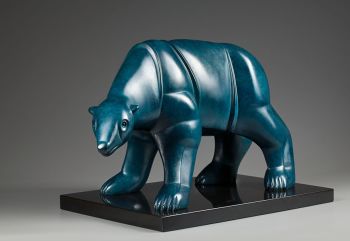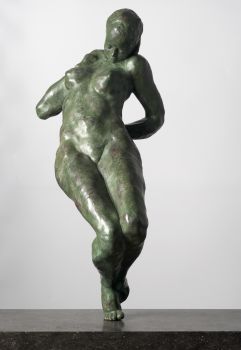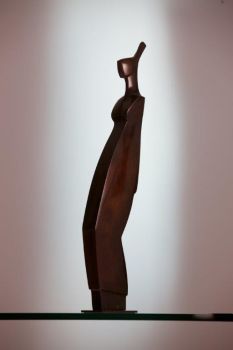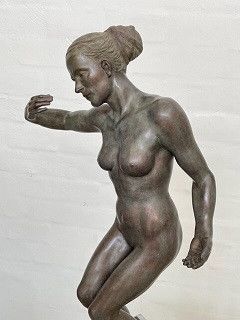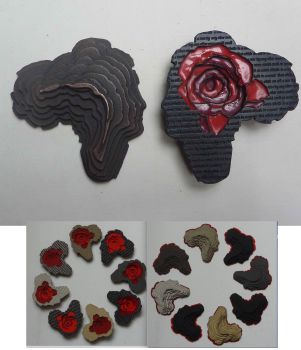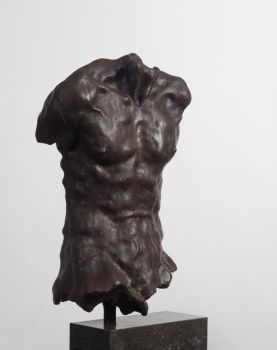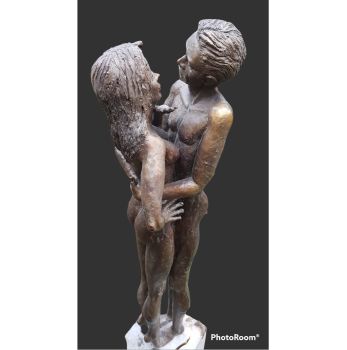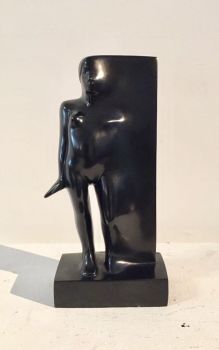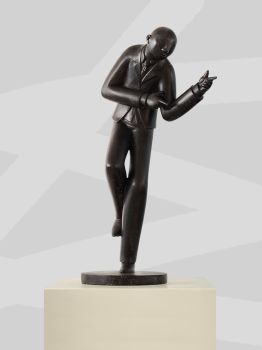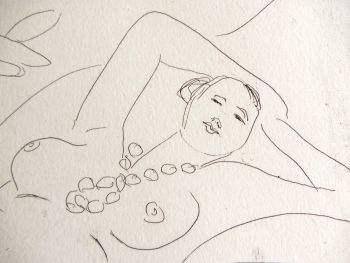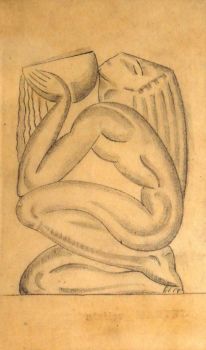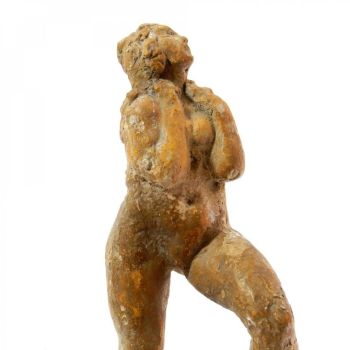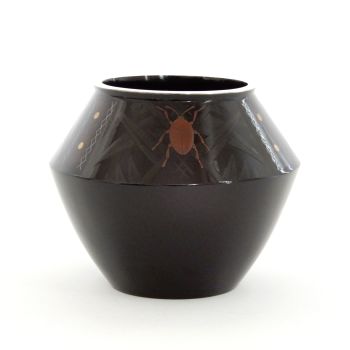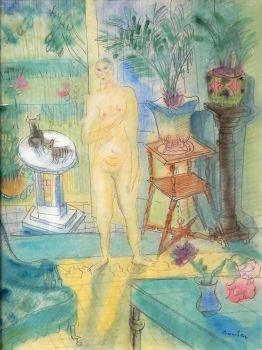Fillette à robe à volant 1948
Léon Indenbaum
BronzoMetallo
50 ⨯ 13 ⨯ 11 cm
ConditionExcellent
Prezzo su richiesta
Dille Art
- A proposito di opere d'arteThere's something touching about this girl in her prettiest ruffled dress with a bow in her hair. Indenbaum made this sculpture of plaster in 1948. So far, 7 of the 8 copies have been cast in bronze. This is number 7/8.
It stands on a beautiful marble pedestal and is extensively signed with "Inden, 7/8" and the hallmark of the bronze founder Barthélemy.
----
The family had this sculpture cast in bronze posthumously, because the family believes that their grandfather's sculptures should be seen, they want to give the name Indenbaum the attention and fame it deserves. Léon Indenbaum is known to connoisseurs and is inextricably linked to the Ecole de Paris. Yet they only want to sell a few works, to a very limited extent.
These posthumous sculptures are therefore a first and also the last edition of a maximum of 12. Each sculpture is numbered and officially registered, maximum 8 are numbered 1-8 and four of them are signed EA I to EA IV. (EA stands for Epreuve d'Artiste). This is number 3/8. More examples will not be cast either.
This sculpture also includes an official certificate signed by Léon Indenbaum's grandson. This sculpture with certificate is also registered with ADAGP (Société des authors dans les arts graphiques et plastiques) in Paris.
Biography:
Leon Indenbaum (Tcherikov, now Belarus, 1890 - Opio, 1981), was a Russian/French sculptor who belonged to the group of artists of the École de Paris. His art was innovative, inspired by the classics, but also by African art, the Cubism and Expressionism.
Léon Indenbaum grew up in the shtetl (Eastern European Jewish village) Tcherikov, with his grandfather, who was a bookbinder of art books. After primary school, he was educated as a woodworker. The director of that school thought he was so talented that he arranged for him to attend the Academy of Decorative Arts in Vilnius.
After this training, Indenbaum wanted more and was admitted to the Imperial Academy in Odessa. He went through it for a few years until he crossed a wrong box on a form, he had accidentally signed for 5 years military service in the Imperial Army.
He already had contacts with an artist friend who was in Paris, where so much was happening in the field of art.
Indenbaum managed to escape from Vilnius with the help of an engineer and arrived in Paris in March 1911.
He ended up in 'La Ruche' in Montparnasse, a kind of artists' village.
La Ruche was a circular building, it served as a wine pavilion at the 1900 World's Fair, and was rebuilt by the successful artist Alfred Boucher. Boucher wanted to give poor artists a chance to devote themselves completely to their art. La Ruche was a large round building full of studio apartments, each room had the shape of a slice of pie, in the point a space for a kitchen and storage and above the door was a small loft where you could sleep, often such a studio also had to be shared.
Indenbaum got a studio on the 2nd floor, next to Chagall, who, like himself, had also just arrived from Russia. Indenbaum lived in La Ruche until 1927.
He did have a second studio in Montparnasse for a while.
In total, about 200 artists lived in La Ruche, many of them were from Eastern Europe and many of them were Jewish. Some of them have become world famous with their art, think of Chaïm Soutine, Ossip Zadkine, Jacques Lipschitz, Chana Orloff, Michael Kikoïne, Moïse Kisling , Amadeo Modigliani to name a few.
From 1911 to 1919, Indenbaum studied
sculpture at the Académie La Grande Chaumière, his mentor was the sculptor and painter Antoine Bourdelle, first as a student, later also as his assistant.
In 1912 Indenbaum already exhibited at the Paris Salon d'Artistes Indépendents, he was very poor and his choice of materials was cheap. Jacques Doucet, the great art collector and famous couturier, saw a bust of Indenbaum and summoned him to his home, he wanted the same bust made in a different material, Indenbaum managed to get a piece of onyx.
Doucet was very pleased and asked Indenbaum to make a relief for his round dining room. Indenbaum received 1000 francs per month. Indenbaum had found his patron.
He made one of his most impressive reliefs, entitled 'Musiciens et antelopes' from 1914, made of pink onyx. It was auctioned at Christie's in 2004 for 3.3 million euros.
Besides Jacques Doucet, the couturier René Poiret, the bankers George and Marcel Bénard and the decorator, designer and collector Marcel Coard were regular customers of Léon Indenbaum's sculptures and reliefs.
Léon fell in love with Céline Hénin, she became his muse and his wife, at the end of 1914 they had a daughter, Dinah. Indenbaum was doing well. He had many friends, such as the artists Chaim Soutine, Amadeo Modigliani, with whom he also shared a studio for a period, Tsuguharu Foujita, Chana Orloff, Michael Kikoïne, and Diego Rivera.
Amadeo Modigliani and Diego Rivera both portrayed Indenbaum in 1913 and 1916. Indenbaum himself also portrayed several of his friends. It was the happiest period of his life.
With the stock market crash of 1929, life became much more difficult, people lost their fortunes and could no longer afford works of art. The political situation in France also changed.
The artists from La Ruche and Montparnasse were mostly migrants, at the Paris Salon they were not allowed to exhibit their work among the French artists, an art critic, André Warnod, had given them the nickname 'École de Paris', to show that this innovative avant-garde garde art was also French art. In the 1930s this name was used derogatorily, they were looked down upon, their art was called depraved and because many of them were Jewish, there was also anti-Semitism. They were ignored in the press and in the late 1930s they were no longer allowed to exhibit.
Some artists went abroad. When the war broke out, many had to flee or go into hiding. Indenbaum also had to leave Paris in a hurry. He found a hiding place in a village in the Seine et Marne, where he always got his clay. He was lucky and survived the war, more than 60 percent of the Jewish artists in La Ruche died in the camps.
After the war, Indenbaum settled in Paris again. His studio had been looted and what was left was sometimes destroyed. He lived a very withdrawn life. He had already been separated from Céline before the war, his daughter lived in the south of France. His friends had either not survived the war or had become much too commercial in his view.
He never wanted to commit to a gallery, he felt that he sold his soul, his independence as an artist was at stake, the result was that he was ignored by a large part of the art world. His now famous friends had signed and they were doing well.
Indenbaum wanted nothing more than to work in complete freedom, but in doing so he made it very difficult for him self. He also refused, for example, major commissions from the French state for work on monuments and facades of special buildings.
He was, however, one of the founders of the "Groupe des neuf", a group of nine sculptors who gathered on November 11, 1963 at the statue of Balzac on Avenue Raspail, made by Auguste Rodin.
It was a tribute. They wanted to create a monument to French post-war figurative sculpture at a time when American art was beginning to take over.
The 'Groupe des neuf' consisted of Jean Carton, Paul Cornet, Raymond Corbin, Marcel Damboise, Léon Indembaum, Léopold Kretz, Raymond Martin, Gunnar Nilsson and Jean Osouf. It was a success, there were several exhibitions ofthe group, including in Musée Rodin, a total of 22 sculptors joined the group.
In 1968 Indenbaum received the prestigious Prix de sculpture Georges Wildenstein, from the Institut de France, for his entire oeuvre. In the same year he decided to move to his daughter in Opio. He died at the age of 91. A long life entirely devoted to creating art.
Léon Indenbaum's work can be seen in various museums, including in the United States, Switzerland, Russia, Belarus, Israel and of course in France. Sometimes his work is also auctioned at the major auction houses such as Christies, Sotheby's and MacDougall in London.
Dille Art is the only gallery that represents Léon Indenbaum's sculptures in collaboration with the family of Indenbaum.
Literature and sources:
- Family of Indenbaum
- Jeanine Warnod; "Les artistes de Montparnasse, la Ruche", Éditions Mayer-Van Wilder, Paris 1988. P.42-47, 8, 87,96, 104, 159, 162, 170, 192.
- Nieszawer & Princ; "Histoires des artistes Juifs de l'École de Paris, 1905-1939", Édition Les Étoiles, 2020. P. 190-192, 515 and 516.
- Jeanine Warnod; "l'École de Paris", Édition Musée du Montparnasse, 2012. P. 239, 240 and 243.
- "Chagall, Modigliani, Soutine.... Paris pour école, 1905-1940", Éditions Musée d'Art et d'Histoire du Judaïsme (MAHJ), Paris, 2020 et Réunion des Musée nationaux, Grand Palais, 2020. P. 8, 11, 49, 66, 68, 69, 228, 230, 252.
- G. Annenkoff; "Art Russe Moderne", Éditions Laville, Paris, 1928. P. 50 and 51. - A proposito di opere artista
Léon Indenbaum (Tcherikov, ora Bielorussia, 1890 – Opio, 1981), è stato uno scultore russo/francese appartenente al gruppo di artisti dell'École de Paris. La sua arte era innovativa, ispirata ai classici, ma anche all'arte africana, al cubismo e all'espressionismo.
Indenbaum è cresciuto nello shtetl (villaggio ebraico dell'Europa orientale) Tcherikov, con suo nonno, che era un rilegatore di libri d'arte. Dopo la scuola elementare, si è formato come falegname. Il direttore di quella scuola pensava che fosse così talentuoso che gli fece frequentare l'Accademia di arti decorative di Vilnius.
Dopo questo addestramento, Indenbaum volle di più e fu ammesso all'Accademia Imperiale di Odessa. Lo ha passato per alcuni anni fino a quando ha spuntato una casella sbagliata su un modulo, aveva firmato accidentalmente per 5 anni di servizio militare nell'esercito imperiale. Aveva già contatti con un amico artista che si trovava a Parigi, dove tanto stava accadendo nel campo dell'arte. Indenbaum riuscì a fuggire da Vilnius con l'aiuto di un ingegnere e arrivò a Parigi nel marzo 1911.
Finì a 'La Ruche' a Montparnasse, una specie di villaggio di artisti. La Ruche era un edificio circolare, fungeva da padiglione del vino all'Esposizione Universale del 1900 ed è stato ricostruito dall'artista di successo Alfred Boucher. Boucher voleva dare agli artisti poveri la possibilità di dedicarsi completamente alla loro arte. La Ruche era un grande edificio rotondo pieno di monolocali, ogni stanza aveva la forma di una fetta di torta, nella punta uno spazio per cucina e ripostiglio e sopra la porta c'era un piccolo soppalco dove si poteva dormire, spesso un monolocale doveva anche essere ancora condiviso.
Indenbaum prese uno studio al secondo piano, vicino a Chagall, anche lui appena arrivato dalla Russia come lui. Indenbaum visse a La Ruche fino al 1927. Per un po' ebbe un secondo studio a Montparnasse.
In totale, a La Ruche vivevano circa 200 artisti, molti dei quali provenivano dall'Europa dell'Est e molti di loro erano ebrei. Alcuni di loro sono diventati famosi in tutto il mondo con la loro arte, si pensi a Chaïm Soutine, Ossip Zadkine, Jacques Lipschitz, Chana Orloff, Michael Kikoïne, Moïse Kisling, Amadeo Modigliani per citarne alcuni.
Dal 1911 al 1919, Indenbaum studiò scultura all'Académie La Grande Chaumière con lo scultore e pittore Antoine Bourdelle, prima come allievo, poi anche come suo assistente.
Nel 1912, Indenbaum esponeva già al Salon d'Artistes Indépendents di Parigi, era molto povero e la sua scelta dei materiali era a buon mercato. Jacques Doucet, il grande collezionista d'arte e famoso stilista, vide un busto di Indenbaum e lo chiamò a casa sua, voleva lo stesso busto realizzato in un materiale diverso, Indenbaum riuscì ad ottenere un pezzo di onice. Doucet fu molto contento e chiese a Indenbaum di fare un sollievo per la sua sala da pranzo rotonda. Indenbaum riceveva 1000 franchi al mese. Indenbaum aveva trovato il suo patrono. Ha realizzato uno dei suoi rilievi più impressionanti, intitolato "Musiciens et antilopes" del 1914, in onice rosa. È stato venduto all'asta da Christie's nel 2004 per 3,3 milioni di euro.
Oltre a Jacques Doucet, il couturier René Poiret, i banchieri George e Marcel Bénard e il decoratore, designer e collezionista Marcel Coard erano clienti abituali delle sculture e dei rilievi di Léon Indenbaum.
Léon si innamorò di Céline Hénin, lei divenne la sua musa ispiratrice e sua moglie, alla fine del 1914 ebbero una figlia, Dinah. Indenbaum stava andando bene. Aveva molti amici, come gli artisti Chaim Soutine, Amadeo Modigliani, con cui ha condiviso anche uno studio per un periodo, Tsuguharu Foujita, Chana Orloff, Michael Kikoïne e Diego Rivera.
Amadeo Modigliani e Diego Rivera interpretarono entrambi Indenbaum nel 1913 e nel 1916. Indenbaum stesso interpretò anche molti dei suoi amici. Fu il periodo più felice della sua vita.
Con il crollo della borsa del 1929, la vita divenne molto più difficile, le persone persero le loro fortune e non potevano più permettersi opere d'arte. Anche la situazione politica in Francia è cambiata. Gli artisti di La Ruche e Montparnasse erano per lo più migranti, al Salon di Parigi non avevano il permesso di frequentare gli artisti francesi, un critico d'arte, André Warnod, aveva dato loro il soprannome di 'École de Paris', per dimostrare che questo innovativo l'arte d'avanguardia era anche arte francese. Negli anni '30 questo nome era usato in modo dispregiativo, erano disprezzati, la loro arte era chiamata depravata e poiché molti di loro erano ebrei, c'era anche l'antisemitismo. Furono ignorati dalla stampa e alla fine degli anni '30 non fu più permesso loro di esporre. Alcuni artisti sono andati all'estero. Quando scoppiò la guerra, molti dovettero fuggire o nascondersi. Anche Indenbaum ha dovuto lasciare Parigi in fretta e furia. Trovò un nascondiglio in un villaggio della Seine et Marne, dove trovava sempre la sua argilla. Fu fortunato e sopravvisse alla guerra, più del 60 percento degli artisti ebrei a La Ruche morì nei campi.
Dopo la guerra, Indenbaum si stabilì di nuovo a Parigi. Il suo studio era stato saccheggiato e ciò che era rimasto a volte veniva distrutto. Ha vissuto molto ritirato. Era già stato separato da Céline prima della guerra, sua figlia viveva nel sud della Francia. I suoi amici non erano sopravvissuti alla guerra o, a suo avviso, erano diventati troppo commerciali.
Non ha mai voluto impegnarsi in una galleria, sentiva di aver venduto la sua anima, era in gioco la sua indipendenza di artista, il risultato è stato che è stato ignorato da gran parte del mondo dell'arte. I suoi ormai famosi amici avevano firmato e stavano andando bene. Indenbaum non voleva altro che lavorare in completa libertà, ma così facendo ha gettato i suoi occhiali. Ha anche rifiutato, ad esempio, importanti commissioni dello stato francese per lavori su monumenti e facciate di edifici speciali.
Nel 1968 Indenbaum ricevette dall'Institut de France il prestigioso Prix de Sculpture Georges Wildenstein per l'intera sua opera. Negli ultimi anni ha vissuto con la figlia a Opio. Morì all'età di 91 anni. Una lunga vita interamente dedicata alla creazione dell'arte.
Il lavoro di Léon Indenbaum può essere visto in vari musei, inclusi Stati Uniti, Svizzera, Russia, Bielorussia, Israele e ovviamente in Francia. A volte le sue opere vengono messe all'asta anche nelle principali case d'asta come Christies, Sotheby's e MacDougall a Londra.
Sei interessato ad acquistare questa opera d'arte?
Artwork details
Related artworks
- 1 - 4 / 5
Willem van Konijnenburg
Landscape in Limburg, the south of the Netherlands1868 - 1943
Price on requestKunsthandel Pygmalion
1 - 4 / 24- 1 - 4 / 24
Mary Alacoque Waters
'Unknown Twins' after Rafael1999 - 2004
Price on requestGalerie Mia Joosten Amsterdam
1 - 4 / 24- 1 - 4 / 24
Unknown artist
Japanese art deco lacquervase with Scarab beetle motif1920 - 1950
Price on requestDille Art
1 - 4 / 12

